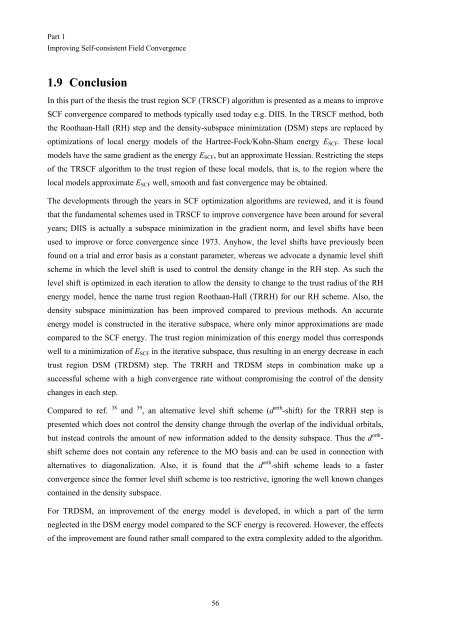Get my PhD Thesis
Get my PhD Thesis
Get my PhD Thesis
Create successful ePaper yourself
Turn your PDF publications into a flip-book with our unique Google optimized e-Paper software.
Part 1<br />
Improving Self-consistent Field Convergence<br />
1.9 Conclusion<br />
In this part of the thesis the trust region SCF (TRSCF) algorithm is presented as a means to improve<br />
SCF convergence compared to methods typically used today e.g. DIIS. In the TRSCF method, both<br />
the Roothaan-Hall (RH) step and the density-subspace minimization (DSM) steps are replaced by<br />
optimizations of local energy models of the Hartree-Fock/Kohn-Sham energy E SCF . These local<br />
models have the same gradient as the energy E SCF , but an approximate Hessian. Restricting the steps<br />
of the TRSCF algorithm to the trust region of these local models, that is, to the region where the<br />
local models approximate E SCF well, smooth and fast convergence may be obtained.<br />
The developments through the years in SCF optimization algorithms are reviewed, and it is found<br />
that the fundamental schemes used in TRSCF to improve convergence have been around for several<br />
years; DIIS is actually a subspace minimization in the gradient norm, and level shifts have been<br />
used to improve or force convergence since 1973. Anyhow, the level shifts have previously been<br />
found on a trial and error basis as a constant parameter, whereas we advocate a dynamic level shift<br />
scheme in which the level shift is used to control the density change in the RH step. As such the<br />
level shift is optimized in each iteration to allow the density to change to the trust radius of the RH<br />
energy model, hence the name trust region Roothaan-Hall (TRRH) for our RH scheme. Also, the<br />
density subspace minimization has been improved compared to previous methods. An accurate<br />
energy model is constructed in the iterative subspace, where only minor approximations are made<br />
compared to the SCF energy. The trust region minimization of this energy model thus corresponds<br />
well to a minimization of E SCF in the iterative subspace, thus resulting in an energy decrease in each<br />
trust region DSM (TRDSM) step. The TRRH and TRDSM steps in combination make up a<br />
successful scheme with a high convergence rate without compromising the control of the density<br />
changes in each step.<br />
Compared to ref. 38 and 39 , an alternative level shift scheme (d orth -shift) for the TRRH step is<br />
presented which does not control the density change through the overlap of the individual orbitals,<br />
but instead controls the amount of new information added to the density subspace. Thus the d orth -<br />
shift scheme does not contain any reference to the MO basis and can be used in connection with<br />
alternatives to diagonalization. Also, it is found that the d orth -shift scheme leads to a faster<br />
convergence since the former level shift scheme is too restrictive, ignoring the well known changes<br />
contained in the density subspace.<br />
For TRDSM, an improvement of the energy model is developed, in which a part of the term<br />
neglected in the DSM energy model compared to the SCF energy is recovered. However, the effects<br />
of the improvement are found rather small compared to the extra complexity added to the algorithm.<br />
56

















